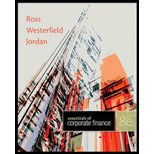
Essentials of Corporate Finance
8th Edition
ISBN: 9780078034756
Author: Stephen A. Ross, Randolph W. Westerfield, Bradford D. Jordan
Publisher: MCGRAW-HILL HIGHER EDUCATION
expand_more
expand_more
format_list_bulleted
Concept explainers
Question
Chapter 17.3, Problem 17.3BCQ
Summary Introduction
To discuss: The meaning of the terms “3/45, net 90” and effective annual rate.
Introduction:
Credit policy refers to a set of procedures that include the terms and conditions for providing goods on credit and principles for making collections. Terms of sale, credit analysis, and collection policy are the three basic elements of credit policy followed by particular company.
Expert Solution & Answer
Want to see the full answer?
Check out a sample textbook solution
Students have asked these similar questions
Dear tutor soln
Need soln quic
I need ans..
Chapter 17 Solutions
Essentials of Corporate Finance
Ch. 17.1 - Prob. 17.1ACQCh. 17.1 - Prob. 17.1BCQCh. 17.1 - Prob. 17.1CCQCh. 17.1 - Prob. 17.1DCQCh. 17.2 - Prob. 17.2ACQCh. 17.2 - Prob. 17.2BCQCh. 17.2 - Prob. 17.2CCQCh. 17.2 - Prob. 17.2DCQCh. 17.3 - Prob. 17.3ACQCh. 17.3 - Prob. 17.3BCQ
Ch. 17.3 - Prob. 17.3CCQCh. 17.4 - Prob. 17.4ACQCh. 17.4 - Prob. 17.4BCQCh. 17.4 - Prob. 17.4CCQCh. 17 - Prob. 1CTCRCh. 17 - Cash Management. What options are available to a...Ch. 17 - LO1 17.3Agency Issues. Are stockholders and...Ch. 17 - Prob. 4CTCRCh. 17 - Short-Term Investments. Why is a preferred stock...Ch. 17 - Prob. 6CTCRCh. 17 - Float. Suppose a firm has a book balance of 2...Ch. 17 - Prob. 8CTCRCh. 17 - Agency Issues. It is sometimes argued that excess...Ch. 17 - Use of Excess Cash. One option a firm usually has...Ch. 17 - Use of Excess Cash. Another option usually...Ch. 17 - Float. An unfortunately common practice goes like...Ch. 17 - Credit Instruments. Describe each of the...Ch. 17 - Trade Credit Forms. In what form is trade credit...Ch. 17 - Receivables Costs. What are the costs associated...Ch. 17 - Prob. 16CTCRCh. 17 - Credit Period Length. What are some of the factors...Ch. 17 - Credit Period Length. In each of the following...Ch. 17 - Prob. 19CTCRCh. 17 - Prob. 20CTCRCh. 17 - Prob. 1QPCh. 17 - Prob. 2QPCh. 17 - Prob. 3QPCh. 17 - Prob. 4QPCh. 17 - Prob. 5QPCh. 17 - Prob. 6QPCh. 17 - Prob. 7QPCh. 17 - Prob. 8QPCh. 17 - Prob. 9QPCh. 17 - Prob. 10QPCh. 17 - Prob. 11QPCh. 17 - Prob. 12QPCh. 17 - Prob. 13QPCh. 17 - Prob. 14QPCh. 17 - Prob. 15QPCh. 17 - Safety Stocks and Order Points. Sach, Inc.,...
Knowledge Booster
Learn more about
Need a deep-dive on the concept behind this application? Look no further. Learn more about this topic, finance and related others by exploring similar questions and additional content below.Similar questions
- solve this problem qn ??arrow_forwardWhich of the following is not an investment grade credit rating?* BB+ BBB+ BBB BBB-arrow_forwardCompany A has a capital structure of $80M debt and $20M equity. This year, the company reported a net income of $17M. What is Company A's return on equity?* 117.6% 21.3% 85.0% 28.3%arrow_forward
- 12. Which of the following is the formula to calculate cost of capital?* Total assets/Net debt x Cost of debt + Total assets/Equity x Cost of equity Net debt/Equity x Cost of debt + Equity/Net debt x Cost of equity Net debt x Cost of debt + Equity x Cost of equity Net debt/Total assets x Cost of debt + Equity/Total assets x Cost of equity .arrow_forwardno ai .What is the enterprise value of a business?* The market value of equity of the business The book value of equity of the business The entire value of the business without giving consideration to its capital structure The entire value of the business considering its capital structurearrow_forward10. The concept of time value of money is that* The cash flows that occur earlier are more valuable than cash flows that occur later The cash flows that occur earlier are less valuable than cash flows that occur later The longer the time cash flows are invested, the more valuable they are in the future The future value of cash flows are always higher than the present value of the cash flows .arrow_forward
- 9. Which of the following is true when a bond is trading at a discount?* Coupon Rate > Current Yield > Yield to Maturity Coupon Rate < Current Yield < Yield to Maturity Coupon Rate = Current Yield = Yield to Maturity Coupon Rate < Current Yield = Yield to Maturity.arrow_forwardWhen the price of a bond is above the face value, the bond is said to be* Trading at par Trading at a premium Trading at a discount Trading below pararrow_forward7. What is a par value of a bond?* The amount borrowed by the issuer of the bond and returned to the investors when the bond matures The overall return earned by the bond investor when the bond matures The difference between the amount borrowed by the issuer of bond and the amount returned to investors at maturity The size of the coupon investors receive on an annual basisarrow_forward
arrow_back_ios
SEE MORE QUESTIONS
arrow_forward_ios
Recommended textbooks for you
 EBK CONTEMPORARY FINANCIAL MANAGEMENTFinanceISBN:9781337514835Author:MOYERPublisher:CENGAGE LEARNING - CONSIGNMENT
EBK CONTEMPORARY FINANCIAL MANAGEMENTFinanceISBN:9781337514835Author:MOYERPublisher:CENGAGE LEARNING - CONSIGNMENT

EBK CONTEMPORARY FINANCIAL MANAGEMENT
Finance
ISBN:9781337514835
Author:MOYER
Publisher:CENGAGE LEARNING - CONSIGNMENT
